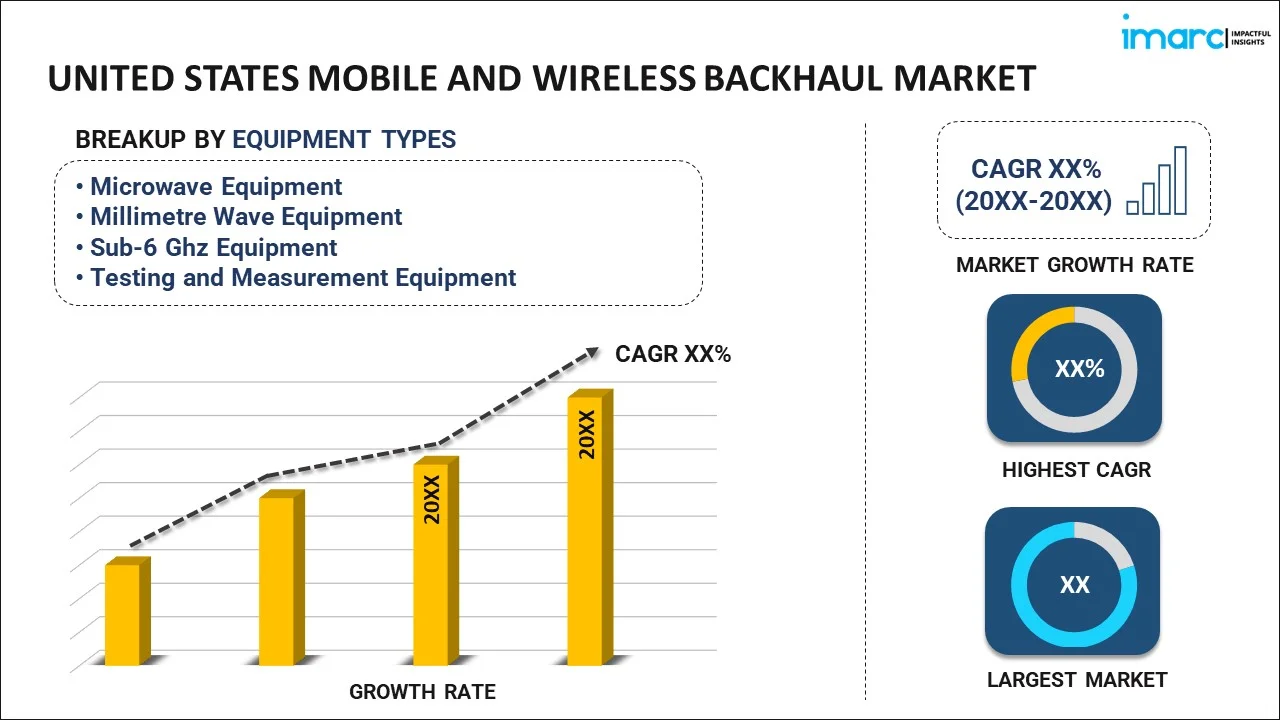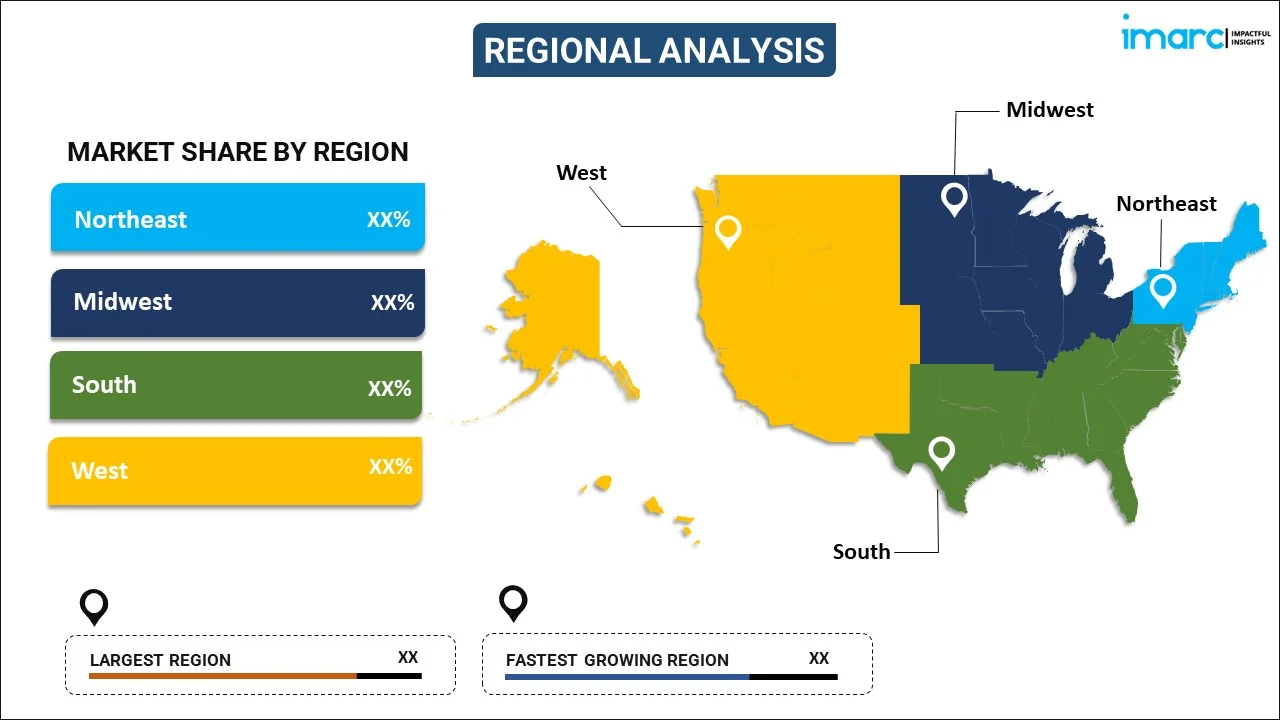
United States Mobile and Wireless Backhaul Market Report by Equipment Type (Microwave Equipment, Millimetre Wave Equipment, Sub-6 Ghz Equipment, Testing and Measurement Equipment), Network Topology (Point to Point Configuration (PTP), Point to Multipoint Configuration (PTM)), Services (Network Services, System Integration Services, Professional Services), and Region 2025-2033
Market Overview:
United States mobile and wireless backhaul market size reached USD 9.9 Billion in 2024. Looking forward, IMARC Group expects the market to reach USD 20.8 Billion by 2033, exhibiting a growth rate (CAGR) of 8.7% during 2025-2033. The rising need for upgrading their networks to internet protocol (IP) for providing high-performance and integrated voice and data services is primarily augmenting the market growth.
|
Report Attribute
|
Key Statistics
|
|---|---|
|
Base Year
|
2024 |
|
Forecast Years
|
2025-2033
|
|
Historical Years
|
2019-2024
|
| Market Size in 2024 | USD 9.9 Billion |
| Market Forecast in 2033 | USD 20.8 Billion |
| Market Growth Rate (2025-2033) | 8.7% |
Mobile backhaul (MBH) involves linking the air interfaces of cell sites to data centers through both wired and wireless networks. This facilitates advanced network timing, ensures high network speed, and rapidly serves users while synchronizing operations, administration, maintenance, and provisioning (OAMP). Conversely, wireless backhauls utilize microwave and satellite communication infrastructure to transmit internet, voice, and video data from nodes to the central network. This method is increasingly gaining popularity compared to wired networks, which necessitate extensive macro sites and contribute to the overall infrastructure expenses.
United States Mobile and Wireless Backhaul Market Trends:
The United States mobile and wireless backhaul market plays a pivotal role in connecting cell site air interfaces to data centers, forming a critical component of the nation's telecommunications infrastructure. Mobile backhaul (MBH) involves the linkage of cell site air interfaces to data centers through both wired and wireless networks. This process supports advanced network timing, ensures high-speed connectivity for users, and synchronizes the operational aspects of administration, maintenance, and provisioning (OAMP). Additionally, in parallel, wireless backhauls utilize microwave and satellite communication infrastructure to efficiently transmit internet, voice, and video data from nodes to the central network. Besides this, the United States market showcases a notable shift toward wireless backhauls due to their advantages over traditional wired networks, such as reducing the need for extensive macro sites and mitigating overall infrastructure costs. Moreover, as the demand for seamless connectivity and high-speed data transmission continues to surge, the United States mobile and wireless backhaul market is poised for sustained growth, driven by technological advancements and the evolving needs of the telecommunications industry to meet the demands of a digitally connected society. In addition, the implementation of high-speed long-term evolution (LTE) connections has expanded the availability of mobile data networks. This, coupled with the increasing prevalence of wireless communication networks, is expected to fuel the growth of the market over the forecasted period.
United States Mobile and Wireless Backhaul Market Segmentation:
IMARC Group provides an analysis of the key trends in each segment of the market, along with forecasts at the country level for 2025-2033. Our report has categorized the market based on equipment type, network topology, and services.
Equipment Type Insights:

- Microwave Equipment
- Millimetre Wave Equipment
- Sub-6 Ghz Equipment
- Testing and Measurement Equipment
The report has provided a detailed breakup and analysis of the market based on the equipment type. This includes microwave equipment, millimetre wave equipment, sub-6 GHZ equipment, and testing and measurement equipment.
Network Topology Insights:
- Point to Point Configuration (PTP)
- Point to Multipoint Configuration (PTM)
A detailed breakup and analysis of the market based on the network topology have also been provided in the report. This includes point to point configuration (PTP) and point to multipoint configuration (PTM).
Services Insights:
- Network Services
- System Integration Services
- Professional Services
The report has provided a detailed breakup and analysis of the market based on the services. This includes network services, system integration services, and professional services.
Regional Insights:

- Northeast
- Midwest
- South
- West
The report has also provided a comprehensive analysis of all the major regional markets, which include Northeast, Midwest, South, and West.
Competitive Landscape:
The market research report has also provided a comprehensive analysis of the competitive landscape. Competitive analysis such as market structure, key player positioning, top winning strategies, competitive dashboard, and company evaluation quadrant has been covered in the report. Also, detailed profiles of all major companies have been provided.
United States Mobile and Wireless Backhaul Market Report Coverage:
| Report Features | Details |
|---|---|
| Base Year of the Analysis | 2024 |
| Historical Period | 2019-2024 |
| Forecast Period | 2025-2033 |
| Units | Billion USD |
| Scope of the Report | Exploration of Historical and Forecast Trends, Industry Catalysts and Challenges, Segment-Wise Historical and Predictive Market Assessment:
|
| Equipment Types Covered | Microwave Equipment, Millimetre Wave Equipment, Sub-6 Ghz Equipment, Testing and Measurement Equipment |
| Network Topologies Covered | Point to Point Configuration (PTP), Point to Multipoint Configuration (PTM) |
| Services Covered | Network Services, System Integration Services, Professional Services |
| Regions Covered | Northeast, Midwest, South, West |
| Customization Scope | 10% Free Customization |
| Post-Sale Analyst Support | 10-12 Weeks |
| Delivery Format | PDF and Excel through Email (We can also provide the editable version of the report in PPT/Word format on special request) |
Key Questions Answered in This Report:
- How has the United States mobile and wireless backhaul market performed so far and how will it perform in the coming years?
- What has been the impact of COVID-19 on the United States mobile and wireless backhaul market?
- What is the breakup of the United States mobile and wireless backhaul market on the basis of equipment type?
- What is the breakup of the United States mobile and wireless backhaul market on the basis of network topology?
- What is the breakup of the United States mobile and wireless backhaul market on the basis of services?
- What are the various stages in the value chain of the United States mobile and wireless backhaul market?
- What are the key driving factors and challenges in the United States mobile and wireless backhaul?
- What is the structure of the United States mobile and wireless backhaul market and who are the key players?
- What is the degree of competition in the United States mobile and wireless backhaul market?
Key Benefits for Stakeholders:
- IMARC’s industry report offers a comprehensive quantitative analysis of various market segments, historical and current market trends, market forecasts, and dynamics of the United States mobile and wireless backhaul market from 2019-2033.
- The research report provides the latest information on the market drivers, challenges, and opportunities in the United States mobile and wireless backhaul market.
- Porter's five forces analysis assist stakeholders in assessing the impact of new entrants, competitive rivalry, supplier power, buyer power, and the threat of substitution. It helps stakeholders to analyze the level of competition within the United States mobile and wireless backhaul industry and its attractiveness.
- Competitive landscape allows stakeholders to understand their competitive environment and provides an insight into the current positions of key players in the market.
Need more help?
- Speak to our experienced analysts for insights on the current market scenarios.
- Include additional segments and countries to customize the report as per your requirement.
- Gain an unparalleled competitive advantage in your domain by understanding how to utilize the report and positively impacting your operations and revenue.
- For further assistance, please connect with our analysts.
 Inquire Before Buying
Inquire Before Buying
 Speak to an Analyst
Speak to an Analyst
 Request Brochure
Request Brochure
 Request Customization
Request Customization




.webp)




.webp)












